Belfast tree strategy report locates priority areas for new greenery

A new report has located priority areas for growing trees in Belfast, with North Belfast highlighted as the quarter most deprived of greenery.
Belfast Council has completed a comprehensive "tree opportunity mapping exercise" as part of its Belfast Tree Strategy. The Tree Establishment report aims to address areas such as existing tree canopy cover, tree equity, species suitability and investigate potential space for new tree planting in both soft and hard landscapes. It also links into the council’s One Million Trees initiative.
Elected representatives agreed for the report to be published at the council's recent meeting of its People and Communities Committee.
READ MORE: Belfast Council told "abusive" pet owners turning Giant's Ring into "dog toilet"
READ MORE: Belfast alley gate delays leave city councillors "frustrated"
The Tree Establishment Report states tree canopy cover across Belfast averages 18.6 percent, as measured by Google satellite data. This ranges from 20.8 percent in urban and suburban areas, to 15.0 percent in rural areas.
The ward with the highest tree cover in Belfast is Bellevue, with 43.9 percent tree cover and the lowest is Ardoyne with just 4.6 percent. The average tree canopy cover for Northern Ireland is 11.8 percent.
A hotspot map of Belfast ranking land parcels for tree planting shows priority areas concentrated in the north and north east of the city, with pockets in the south and west.
In areas of “soft landscape,” that is, land covered by natural surfaces, rather than man made, the top priority areas for tree establishment are Duncairn at number one, then Ballymacarrett, Twinbrook, Woodvale, and Water Works. These are followed by Turf Lodge, Ballymurphy, Forth River, Poleglass, and Falls.
If all potential plantable soft landscape space was covered by canopy, the report states, Belfast could have 41.9 percent canopy cover.
In areas of “hard landscape,” that is, manmade hard surfaces such as asphalt and concrete, the top ten priority areas are Duncairn, Blackstaff, Shankill, Falls, Water Works, New Lodge, Beersbridge, Woodvale, Clonard, and Ardoyne. Shankill, New Lodge and Woodvale have scores of 100 percent for locations considered high priority.
The current strategy target is 30 percent canopy cover for Belfast by 2050. This is reliant on tree planting continuing at a consistently high rate by all the key landowners across the city. One major problem the strategy faces is Ash Dieback, which threatens 11.3 percent of the overall existing tree population, and could cause the current tree cover to drop significantly.
The Belfast Tree Strategy was produced with the aim of managing and improving the city’s tree-scape over the next ten years. It aims to protect, enhance, and expand the council’s woodlands, hedges, and trees, and to connect people to nature.
The council’s Belfast Tree Strategy Action Plan document prioritises a number of actions, firstly to move from a five to a three year tree health and condition inspection programme for all semi-mature to fully mature park trees, and from a five year to a two year tree health and condition tree inspection programme for the Department for Infrastructure street trees which the council manage.
The plan also recommends a detailed canopy cover assessment including woodlands and hedges, the creation of an “opportunity tree planting plan” for both hard and soft landscape areas across the city, and a “tree equity” mapping exercise, in partnership with the Woodland Trust.
The public response during a consultation last year gave a number of instructions to the council, including that there should be more trees and green spaces within the city boundaries and City Centre with more volunteering.
Respondents said there should be stricter targets for native planting within each council ward, and tree parks needed to be created for “peace and tranquility.”
Respondents said there should be more tree planting in working class communities in North Belfast and around the new university, and there should be more land set aside for orchards.
A council report from last year states: “Equity Mapping looks at tree canopy cover in terms of health, air pollution, education, employment etc. Typically, lower income areas have fewer trees, and this is something which is acknowledged within the Tree Strategy, and it’s recognised that trees should be made available to everyone in all areas of the city.
“The Woodland Trust is working with American Forests to bring Tree Equity Scores to the UK. This will help cities to assess tree cover and to prioritise areas where trees can be planted to provide the greatest benefits to local communities.
“As a result of the close working relationship between the Woodland Trust and Belfast City Council, Belfast along with Birmingham City Council has been chosen by the Woodland Trust and American Forests to test the Tree Equity scoring model before its roll out across all UK cities.”
In March this year, Belfast City Council received confirmation that the city had achieved “Tree Cities of the World status.” This accreditation has been awarded by the Food and Agriculture Organisation of the United Nations to 200 recognised cities across the world. This is the first time Belfast city has been included, and is largely due to the Belfast Tree Strategy.
The new Tree Establishment Strategy document can be found here
For all the latest news, visit the Belfast Live homepage here and sign up to our daily newsletter here.

 Yahoo News
Yahoo News 
